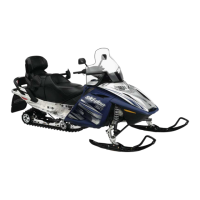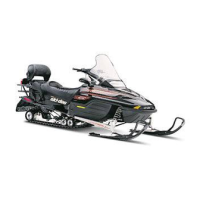RIDING THE VEHICLE
26
SAFETY INFORMATION
Terrain/Riding Variations
Groomed Trail
On a maintained trail, sitting is the most preferred riding
position. Do not race and, above all, keep to the right hand
side of the trail. Be prepared for the unexpected. Observe all
trail signs. Do not zigzag from one side of the trail to the other.
Ungroomed Trail
Unless there has been a fresh snowfall you can expect
“washboard” and snowdrift conditions. Taken at excessive
speeds, such conditions can be physically harmful. Slow
down. Hold on the handlebar and assume a posting position.
Feet should be under the body assuming a crouched position to
absorb any jarring effect. On longer stretches of “washboard”
trails, the kneeling position of one knee on the seat can be
adopted. This provides a certain amount of comfort, while at
the same time keeps the body loose and capable of vehicle
control. Beware of hidden rocks or tree stumps partially hidden
by a recent snowfall.
Deep Snow
In deep “powder” snow, your vehicle could begin to “bog”
down. If this occurs, turn in as wide an arc as possible and
look for a firmer base. If you do get “bogged”, and it happens
to everyone, do not spin your track as this makes the vehicle
sink deeper. Instead, turn the engine off, get off and move
the back of the vehicle onto new snow. Then tramp a clear
path ahead of the vehicle. A few feet will generally suffice.
Restart the engine. Assume the standing position and rock
the vehicle gently as you steadily and slowly apply the throttle.
Depending on whether the front or rear end of the vehicle is
sinking, your feet should be placed on the opposing end of
the running boards. Never place foreign material beneath the
track for support. Do not allow anyone to stand in front of, or
to the rear of, the snowmobile with the engine running. Stay
away from the track. Personal injury will result if contact is
made with the revolving track.

